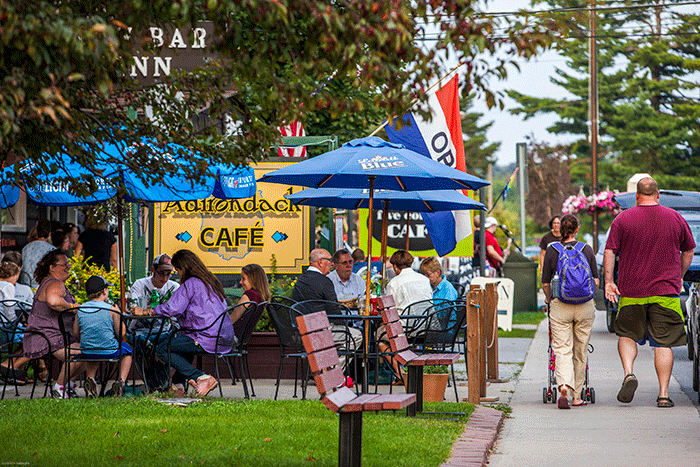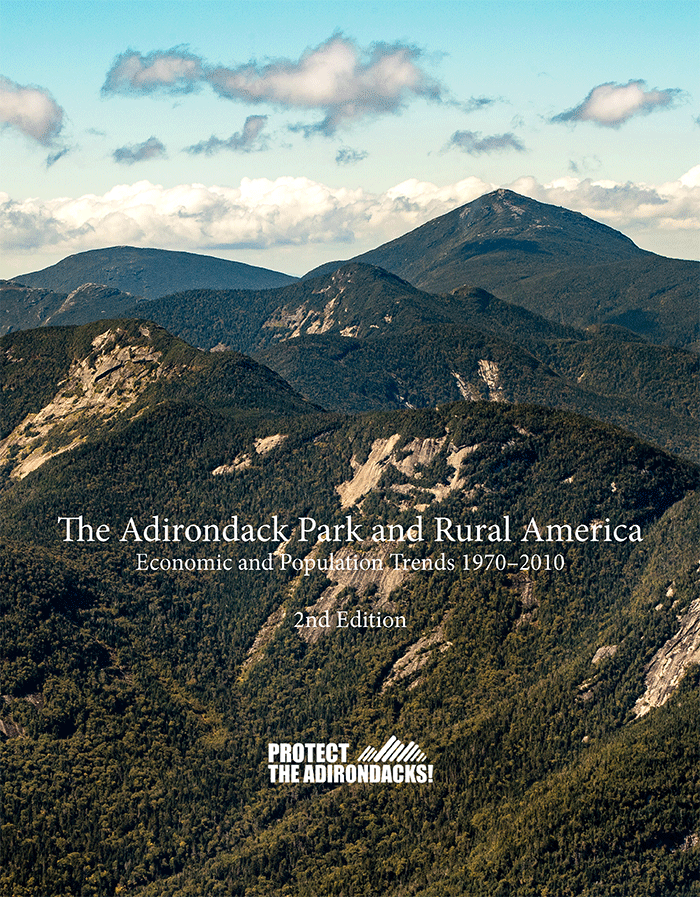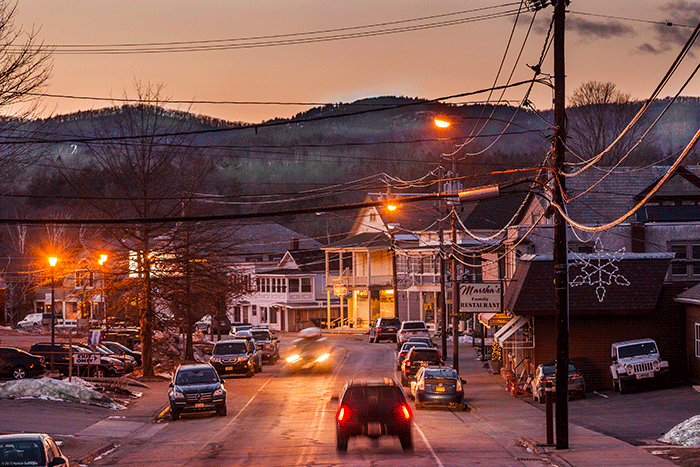Report compares long-term economic and population trends of Adirondack communities with New York State, U.S. and Rural America. Report finds that from 1970 to 2010 Adirondack Park communities experienced economic and population trends that were either consistent with, or exceeded, the trends of other rural areas in New York, the Northeast U.S., or across Rural America.
Protect the Adirondacks is proud to release the new report The Adirondack Park and Rural America: Economic and Population Trends 1970-2010. Long-term economic and population trends of Adirondack communities, starting in 1970 and ending in 2010, were compared in this report. This period coincides with the establishment of regional land-use zoning and a period of sustained land protection in the Adirondack Park. This report analyzes standard economic indicators, including median household income, per capita income, the poverty rate, and the rates of employment and self-employment. It looks at standard population indicators, including population growth, median age, and the ratio of children to adults of childbearing age. The report also examines age groups to compare the experiences of young adults of college age, career age adults, and retirees. In all cases, the experiences of Adirondack communities are compared with other rural areas.
If there were negative economic impacts from environmental protections in the Adirondack Park, the region would stand out as significantly different from other rural areas in trends for median household income, per capita income, poverty rate, and rates of employment and self-employment as well as population indicators over this 40 year time period. Any negative trends due to environmental protection would be clearly evident over the past 40 years. Far from unique, the economic and population challenges facing the Adirondacks are the norm in Rural America. In many cases, Adirondack communities experienced economic growth that was far better than that of vast areas of Rural America.
“While the Adirondack Park has an exceptional, internationally recognized landscape of mountains, forests, wetlands, lakes, and rivers, there is nothing exceptional about the long-term economic or population trends of Adirondack communities. What is happening in the Adirondacks is the same thing that is happening across Rural America,” said Peter Bauer, Executive Director of Protect the Adirondacks. “When compared with areas across New York State, the United States, and Rural America, the economic performance and population trends experienced by Adirondack communities from 1970 to 2010 exceeded or were consistent with those of other rural areas.”
The period 1970 to 2010 was a period of stagnant economic growth in Rural America. Across the U.S., wages were flat, and economic and population growth largely consolidated in major metropolitan areas. By 2010, 68% of the land area in the lower 48 U.S. states was categorized as rural, yet this area was home to just 14.9% of the country’s population. Adirondack communities share a similar population density of around 11 people per square mile with thinly populated rural communities that stretch across 62% of the lower 48 states, a vast landscape that is home to just 6.6% of the U.S. population.
This report relied upon US Census data from five decennial censuses in 1970, 1980, 1990, 2000, and 2010, as well as New York State data for school districts and tax assessments. No mid-decade Census estimates were used. The report is being distributed to local government leaders across the Adirondacks, elected officials and legislative staff in Albany, non-profits, school districts, libraries, and academics throughout the Adirondacks and New York. Click here to read the report.
Report Highlights
Economic Trends:
• From 1970 to 2010, Adirondack communities experienced an increase in median household income of 5.8%, which exceeded the New York State increase of 0.7% and the national decrease of -0.6%.
• From 1970 to 2010, Adirondack communities experienced a higher growth in median household income than did 52% of Rural America counties, home to 63% of the population of Rural America.
• In 2010, Adirondack communities had a higher median household income than did 85% of Rural America counties, home to 83% of the population of Rural America.
• The increase in per capita income of Adirondack communities of 80.3% from 1970 to 2010 exceeded the New York State increase of 58.5% and the national increase of 57.9%.
• The Adirondack communities’ increase in per capita income from 1970 to 2010 exceeded that of 71% of Rural America counties, home to 78% of the population of Rural America.
• From 1970 to 2010, the poverty rate of Adirondack communities (12.3% in 2010) increased by 2.0 percentage points. This was less than the New York State (14.9%) increase of 6.9 percentage points and the U.S. (14.9%) increase of 4.5 percentage points.
• The 2010 poverty rate of Adirondack communities (12.3%) was lower than that of 72% of U.S. counties, home to 68% of the U.S. population.
• The 2010 poverty rate of Adirondack communities (12.3%) was lower than that of 77% of Rural America counties, home to 81% of the population of Rural America.
• The 12.0% growth in the employment rate (16 years and older) of Adirondack communities from 1970 to 2010 was higher than that of 65% of U.S. counties, home to 75% of the U.S. population.
• The 12.0% growth in the employment rate of Adirondack communities from 1970 to 2010 was higher than that of 64% of Rural America counties, home to 73% of the population of Rural America.
• In 2010, the rate of self-employment in Adirondack communities was consistent with rates across Rural America. From 1970 to 2010, Adirondack communities experienced a much higher greater growth in the rate of self-employment.
Population Trends:
• From 1970 to 2010, Adirondack communities experienced a population increase of 10.6%, a rate that exceeded New York State’s population growth of 6.2%, though lagged behind the U.S. growth of 51.9%.
• From 1970 to 2010, one quarter of all counties in the U.S. lost population, but fully one-third of the counties in Rural America lost population. From 2000 to 2010, nearly half (47%) of all counties in Rural America lost population.
• The 10.6% population increase of Adirondack communities from 1970 to 2010 was higher than that of 1,111 counties (36%) with 22% of the U.S. population and 908 rural counties (47%) with 32% of the population of Rural America.
• One out of every six counties (525 counties) in the U.S. has a median age (45.7 years in 2010) equal to or older than that of the Adirondack Park. Across Rural America, 1 out of every 4 counties has a median age equal to or older than the Adirondacks.
• In 2010, the ratio of children (0-14 years old) to adults of childbearing age (20-44 years old) was 0.57:1, similar to New York State’s ratio of 0.53:1 and the U.S. ratio of 0.59:1, but lower than that of other rural areas outside the Northeast U.S.
• In 2010, over 10 million New Yorkers and over 102 million Americans lived in places with a lower ratio of children to adults of childbearing age than that of the Adirondack communities.
• From 1970 to 2010, the 672 New York State school districts we analyzed experienced a loss of 665,293 students, not including New York City. Across New York 88% of school districts in our analysis experienced decreased enrollment in those years. Over 64% of New York school districts experienced a 25% or greater loss of students.
• Adirondack communities are experiencing population patterns similar to those of other rural areas, including decreased school enrollments, the loss of college-age young people, low recruitment of career-age people, and a large older population.
• Through analysis of age groups, Adirondack communities consistently recruited people starting at age 35 at a higher rate than did New York State and the U.S. and were stronger than the recruitment rates seen in other rural areas.
• Adirondack communities stand out from New York, the U.S., and Rural America in their high recruitment rate of retirees.
“The data and analysis of this report make it clear that it is time to stop blaming whatever economic distress we find in the Adirondack Park on environmental protection, either in purchase of land for the Forest Preserve or conservation easement, or through limiting development on private land. We need to stop blaming the Park. The Adirondack Park and its residents and businesses are part of Rural America and subject to all the population and economic pressures experienced by similar regions throughout the United States. Adirondack economic and population trends are fully consistent with the experience of other rural areas across the U.S.,” said Peter Bauer. “What is special about the Adirondack Park is the world-class protected landscape of mountains, forests, lakes and rivers. The abundant, protected natural resources are a key asset and advantage for the region and sets the Adirondack Park apart from most other rural areas.”








